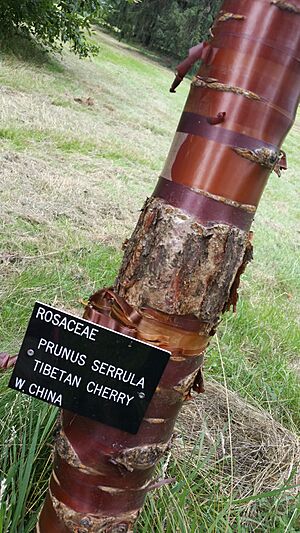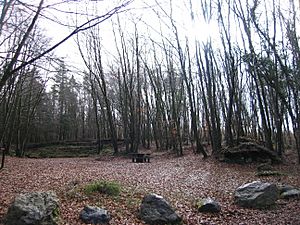Emo Court facts for kids
Emo Court is a grand, old house located near the village of Emo in County Laois, Ireland. It's a beautiful example of Neoclassical style, which means it looks a bit like ancient Greek and Roman buildings. You can spot its special features like tall, elegant windows, fancy balconies, and a big dome on top.
The famous architect James Gandon designed this house in 1790 for John Dawson, who was the first Earl of Portarlington. Gandon also designed other important buildings in Dublin, like the Custom House. Even though construction started in the 1790s, it took a long time to finish. The house was finally completed in the 1860s, many years later!
Over time, Emo Court changed hands several times. In the 1990s, the Irish state took ownership of the house and its beautiful gardens. Now, the Office of Public Works looks after it, and everyone can visit and explore this amazing estate.
Contents
History of Emo Court
Building the Grand House
When John Dawson, the first Earl of Portarlington, passed away in 1798, his new house was still being built. It was far from finished! His son, also named John Dawson, continued the work. He hired new architects to help, and eventually, the house became ready to live in.
However, when the second Earl died 47 years later, the main building was still not fully complete. After a difficult time in Ireland called the Great Famine (from 1845 to 1852), the house almost had to be sold. But by the 1860s, the third Earl, Henry Dawson-Damer, managed to finish Emo Court. It looked very much like it does today. Even though James Gandon started the design, many people worked on the house over the years.
Around the late 1800s, a company from London called Merryweather & Sons installed a modern water system at Emo Court. This system provided water for the house and could even help fight fires. They also put in a special electric lighting system.
Changes in the Early 1900s
Emo Court was at its busiest and most grand in the late 1800s. But after World War I started in 1914, and later the Easter Rising and the War of Independence, the Earls of Portarlington decided to leave Ireland for good. Many wealthy families like them also left.
In 1920, the huge estate, which was about 20 square miles, was sold to the Irish Land Commission. The house itself stayed empty, but most of the land was given to local farmers.
The Jesuits at Emo Court
In 1930, a group of Catholic priests called the Jesuits bought Emo Court. They paid £2000 for the house and 280 acres of land.
The house became known as St Mary's, Emo, and it opened as a training center for new Jesuit priests on August 4, 1930. About 52 young men came to live and study there that year. One of the first priests to live at Emo was a famous photographer named Father Francis Browne. The Jesuits turned the grounds into a working farm and orchard. They also changed some parts of the house inside to create a chapel and a meeting room.
By the 1960s, the Jesuits felt that Emo Court was too far away from everything for their modern training ideas. The number of new priests joining also became smaller. It was expensive to keep such a big house for only a few men. Over 500 young men had started their lives as Jesuits at Emo. In September 1969, the Jesuits moved out and went to Manresa House in Dublin.
Major Cholmeley Harrison and Today
A new chapter began for Emo Court when Major Cholmeley Harrison bought the property from the Jesuits in 1969. He hired a famous architect named Sir Albert Richardson, who was an expert in Georgian architecture, to help restore the house to its former glory.
Even though it was a private home, Major Harrison encouraged people to visit the gardens every Sunday for a small fee.
The final big change happened in 1994. Major Cholmeley Harrison gave Emo Court to the President of Ireland, Mary Robinson, as a gift to the people of Ireland. He continued to live in private apartments there until he passed away in July 2008, at the age of 99. Now, staff from the Office of Public Works (OPW) take care of the entire estate, making sure it stays beautiful for everyone to enjoy.
House and Gardens at Emo Court
When you arrive at Emo Court, you drive through a grand gateway and along a long driveway. This driveway goes through a lovely beech wood before opening up to an avenue lined with huge giant sequoias. These massive trees were first brought to Ireland in 1853 and were named Wellingtonias to honor the Duke of Wellington, a famous general.
There's a visitor car park near the house. To the left, you'll see old coach houses and servants' quarters. To the right are mature trees, and straight ahead is the main entrance. The entrance has a large triangular section called a pediment, supported by four tall Ionic pillars. The Earl's family crest is in the pediment, and on either side, there are old carvings showing farming and art.
Inside the house, there's an eight-sided entrance hall. It has doors in each of its four corners, but only two actually lead to other rooms. The others are just there to make the hall look balanced and grand. A larger doorway leads to the rotunda, which is a key part of the house. It was inspired by the Pantheon in Rome. This rotunda is two stories high and has a dome that rises above the rest of the house. It was finished around 1860. Tall, decorative columns made of Siena marble support the fancy ceiling.

The gardens at Emo Court cover 35 hectares (about 86 acres) of beautifully designed land. They have formal areas, peaceful woodland walks, statues, and a 20-acre lake. This large lake is a common feature in Neoclassical garden designs. Many of the original statues were found in the lake! It's thought they might have been hidden there when the Jesuits lived at the property, perhaps to hide the "pagan" (non-Christian) statues. They survived in the water until they were found and restored.
The gardens are split into two main parts. The Clucker (which comes from an Irish word meaning "convent") has some rare trees and beautiful areas filled with azaleas, rhododendrons, camellias, and other shrubs. The Grapery is an arboretum, which is like a tree museum. It has many pathways that wind through the trees, and some open up to lovely views of the nearby Slieve Bloom Mountains or back towards the house.
See also
- List of Jesuit sites



